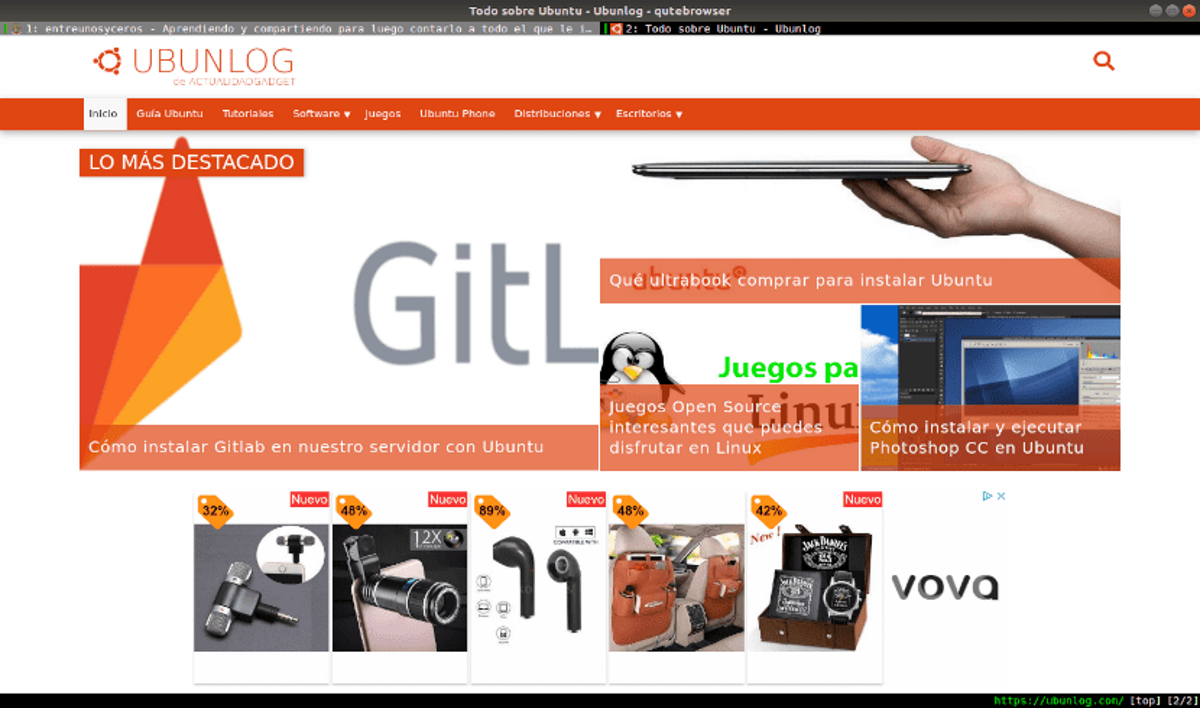
After one month, the launch of the new version has just been presented from the web browser cutebrowser 1.12.0 which stands out from the rest and is characterized by providing a minimal graphical interface that does not distract the user from viewing the content and a navigation system in the style of the Vim text editor. This web browser is entirely based on keyboard combinations.
The browser supports a tab system, download manager, private browsing mode, built-in PDF viewer (pdf.js), ad blocking system (at the host blocking level), an interface to view the history of visits .
To watch videos on YouTube, you can set an external video player call. You can move around the page with the "hjkl" keys, press "o" to open a new page, toggle between the tabs with the "J" and "K" keys or the "Alt-tab number".
When you press ":", a command prompt is displayed, where you can search the page and run typical commands, as in vim, for example, ": q" to exit and ": w" to save the page.
What's new in Qutebrowser 1.12.0?
This new version of the browser arrives with new commands added, one of them is the command «:debug-keytester»Which when typed shows a key test widget. Another new command is the command «: config-diff«, Which when typing it into the browser, what it does is open the browser service page« qute: // configdiff ».
On the other hand, another significant change is the new configuration "colors.contextmenu.disabled. {Fg, bg}" used to change the colors of inactive items in the context menu.
In addition se added a new line selection mode ": toggle-selection –line" which is associated with the keyboard shortcut Shift-V.
As for the added settings, it mentions "colors.webpage.darkmode. *" Which controls the dark mode of the interface.
Of the other changes that stand out from this new version:
- The command ": tab-give –private" now disconnects the tab in a new window with the private mode active.
- The debug flag "–debug-flag log-cookies" was implemented to write all cookies to the log.
- tox -e mkvenv that was deprecated in qutebrowser v1.10.0 is now removed. Use the mkvenv.py script instead.
- Support for using config.bind (key, None) in config.py that an unbind key is deprecated and in v1.8.2 and is now retired. Use config.unbind (key) instead.
- : yank markdown was deprecated in v1.7.0 and is now removed. Use instead: yank inline [{title}] ({url}).
Finally, if you want to know more about this new version or about the browser, you can check the details on its official website. The link is this.
How to install Qutebrowser on Ubuntu and derivatives?
For those who are interested in being able to try this web browser, they should know that the installation in Ubuntu as well as its derivatives is quite simple, since the package is within the Ubuntu repositories
To install the browser, we simply have to open a terminal (you can do it with the key combination Ctrl + Alt + T) and write the following command in it:
sudo apt update
And now we can install the browser with the following command:
sudo apt install qutebrowser -y
And that's it, you can start using this browser on your system.
Another installation method and for those interested in being able to try the new version (since the newer packages take longer to be updated in the Ubuntu repositories)
We can install the browser from the source code which we can obtain from la releases page.
There we we will download the Source code (Zip) package and we will unzip it in our team. To run the browser, just enter the folder and run the following commands:
sudo apt install python3-pip pip3 install --user pyqt5 pypeg2 jinja2 pygments sudo apt-get install python3-venv sudo apt install python3-pyqt5.qtwebengine python3 scripts/mkvenv.py
And we can run the browser with the following command:
python3 qutebrowser.py